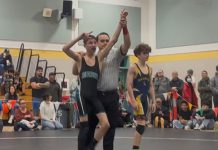Dear Editor,
I would like to respond to the person who contacted
”
Red Phone
”
(Jan. 22 , 2009 edition) to critique the Christopher High School
footprint and traffic flow. I was a member of the CHS Steering
Committee and am also an architect who had his own architectural
and planning firm for 35 years.
City planning forced the traffic flow patterns that surround Christopher High School
Dear Editor,
I would like to respond to the person who contacted “Red Phone” (Jan. 22 , 2009 edition) to critique the Christopher High School footprint and traffic flow. I was a member of the CHS Steering Committee and am also an architect who had his own architectural and planning firm for 35 years.
The lowest portion of the site occurs along Santa Teresa Boulevard where water collects from higher ground to the west. Architects seldom place buildings at the lowest portion of a site where water naturally collects and potential for flooding is greatest unless there is some greater, overriding concern which comes at a cost.
To locate buildings along Santa Teresa would require an inordinate amount of very expensive land fill to overcome the natural site drainage. That would also increase the height differential between Santa Teresa and the new buildings making access more expensive and problematic and would also require a more expensive site drainage system to reverse the natural system. I think the responses by the school architect and others, per Red Phone response, were valid but certainly the site drainage situation would have been a major consideration.
Regarding the traffic pattern, the original proposal was to bring all the traffic from the downtown area north along Santa Teresa and left onto Day Road west. Another left was required from Day onto Cougar Court. Both left hand turns occur at traffic lights and against oncoming traffic. Such turns cause maximum vehicle backup and potential for more accidents. Several of us suggested that such was not an efficient or safe plan.
Right hand turns at traffic signals, on the other hand, allow the traffic to keep moving since you can turn right on a red light and avoid the backup situation and going against oncoming traffic. We proposed that the traffic turn left at Sunrise Drive, where a traffic light already existed (one left hand turn was inevitable) and then turn right, from Sunrise Drive, towards the school. This way the kids could be dropped off on the right hand side of the vehicle and directly onto a sidewalk as opposed to stepping into the traffic side of the vehicle as would have been required if coming from Day Road.
The traffic would then continue along Cougar Court and make a right hand turn onto Day Road and another right hand turn onto Santa Teresa. This system allowed for the maximum of safer right hand turns, less potential for longer backups and accidents and disembarking kids on the safer side of the vehicles.
This suggestion was unanimously approved by the Steering Committee. The assistant police chief, who was present, stated that such plan was much safer and would result in better traffic flow.
Unfortunately, the city would not allow the school traffic to go up Sunrise Drive, therefore the school was forced to put a traffic lane on school property to accomplish what Sunrise Drive could have provided.
This required the additional traffic signal at Santa Teresa and Day Road east for a total of three signals on Santa Teresa in lieu of two.
Some may recall that there was opposition to locating the high school where it is now. Many people thought that Day Road east was a better location as two main streets would have served the school instead of one.
Monterey Road, which is under-utilized, would have been one access, with Santa Teresa as the other. Part of that reasoning was that emergency vehicles, if needed, would have better and quicker access to the school, but also by providing two access streets you don’t overburden the single approach. The school board had two locations on Day Road east that they were considering but arbitrarily dropped.
I hope this response sheds a little more light on how and why the school positioning and traffic pattern were arrived at.
Paul McAllister, Gilroy
VTA planning meetings for possible new ‘Hwy. 152’ route above board and open to public
Dear Editor,
Regarding article “Quiet plans for Highway 152 alternative, possibly with toll,” published Jan. 29: The need to address safety, congestion and movement of goods on Route 152 is no secret. Neither is the interest of Santa Clara and San Benito counties in studying alternatives to address this issue.
For years, there have been numerous public discussions about the importance of this heavily trafficked corridor for the businesses and communities it connects, as well as VTA’s interest, as Santa Clara County’s Congestion Management Agency, in conducting a study to evaluate realignment options.
In January, the VTA entered into a Memorandum of Understanding with the Council of San Benito Governments, which was agendized at a publicly noticed and open meeting, to officially form the Mobility Partnership to look at this issue.
This project is in the very early conceptual planning phase, and no funding for design, environmental work or construction has been identified. Members of the public interested in attending Partnership meetings are welcome to attend, and may subscribe to meeting notices on the VTA Web site, www.vta.org.
Michael T. Burns, general manager,
Santa Clara Valley Transportation Authority
Billions into high-speed rail a huge waste of taxpayer funds
Dear Editor,
The Bullet Train bonds, billions of dollars worth, are not based on sound security because the entity created by the California High Speed Rail Association is conceived insolvent, and will, when built, be born bankrupt, just like the Las Vegas Monorail, the Valley Transportation Authority’s Lite Rail system, Amtrak, Caltrain, and other such socialist government-option transport.
Unlike the land grant railroads, which were profit-making entities (take a look at Union Pacific’s dividend history for the past 150 years), which repaid the taxpayers hundreds of millions more than the value of the land transferred by taxpayers to those entities, the CAHSRA is like Amtrak, Caltrain and other losing fare models (more money is lost with each passenger transported).
So, are we going to learn from our history, or are we going to repeat history and waste billions upon billions? Just how utterly stupid can our leaders be?
Joseph P. Thompson, Gilroy
Toyota recall – is it really the gas pedal, or is it the computer
Dear Editor,
As someone who has been in software for over 30 years I have to ask Toyota this question, “Have you ruled out the computer?”
As I understand it the cars in question are all “drive-by-wire” cars. Unlike the cars I drove as a teen where the gas pedal was connected to the carburetor with metal rods, these days the pedal is an input device that merely indicates to the car’s computer how fast the driver wishes to go.
The computer directly controls the engine speed. Even if the gas pedal was actually sticking, the computer could be programmed to detect a faulty pedal and shut down the engine automatically. Such software would be trivial to implement and could save lives until the real problem is determined. However, there seems to be evidence of cases that defy the pedal theory and that Toyota should be looking at the computer.
Marc Perkel, Gilroy











